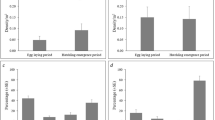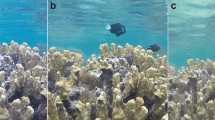Abstract
Protecting eggs from predators is common practice in sea turtle conservation, but routine protection of hatchlings is not. Of 42 loggerhead hatchlings observed emerging from 10 nests on undeveloped Onslow Beach, North Carolina, 24 % were preyed on by ghost crabs. In experimental trials, ghost crabs similarly threatened and captured neonate freshwater sliders, supporting their substitution as proxy for threatened and endangered sea turtle hatchlings in field experiments testing density dependence. Exploiting natural long-shore variation in ghost crab density, we show that a 2.6-fold higher ghost crab density resulted in 5 times more nocturnal threat encounters with sliders and 3.4 times more slider captures. Sliders released in simulated group emergences experienced lower per capita capture risk by ghost crabs than solitary sliders, implying predator dilution. Non-independence of egg and hatchling depredation motivates consideration of merging sea turtle egg and hatchling stages when modeling and managing food web interactions.




Similar content being viewed by others
References
Adam V, Tur C, Rees AF, Tomas J (2007) Emergence pattern of loggerhead turtle (Caretta caretta) hatchlings from Kyparissia Bay, Greece. Mar Biol 151:1743–1749
Arndt BG (1994) Predation on hatchling diamondback terrapin, Malaclemys terrapin (Schoepff), by the ghost crab, Ocypode quadrata (Fabricius) II. Fla Sci 57:1–5
Barton BT, Roth JD (2008) Implications of intraguild predation for sea turtle nest protection. Biol Conserv 141:2139–2145
Bernardo J, Plotkin PT (2007) An evolutionary perspective on the arribada phenomenon and reproductive behavioral polymorphism of Olive Ridley sea turtles (Lepidochelys olivacea). In: Plotkin PT (ed) Biology and conservation of ridley sea turtles. Johns Hopkins University Press, Baltimore, pp 59–86
Bjorndal KA, Bowen BW, Chaloupka M, Crowder LB, Heppell SS, Jones CM, Lutcavage ME, Solow AR, Witherington BE (2010) Assessment of sea-turtle status and trends, integrating demography and abundance. National Academies Press, Washington
Bolten AB, Crowder LB, Dodd MG, MacPherson SL, Musick JA, Schroeder BA, Witherington BE, Long KJ, Snover ML (2011) Quantifying multiple threats to endangered species: an example from loggerhead sea turtles. Front Ecol Environ 9:295–301
Caswell H (1989) Matrix population models: construction, analysis and interpretation. Sinauer, Sunderland
Clarke M, Campbell AC, Hameid WS, Ghoneim S (2000) Preliminary report on the status of marine turtle nesting populations on the Mediterranean coast of Egypt. Biol Conserv 3:363–371
Conant TA (1991) Ghost crab predation on emergent sea turtles from relocated nests on a barrier island, North Carolina. Master thesis, Western Washington University, Bellingham
Cronin TW, Forward RB Jr (1988) The visual pigments of crabs I Photopigments. J Comp Physiol A 162:463–478
Crouse DT, Crowder LB, Caswell H (1987) A stage-based population-model for loggerhead sea-turtles and implications for conservation. Ecology 68:1412–1423
Glen F, Broderick AC, Godley BJ, Hays GC (2005) Patterns in the emergence of green (Chelonia mydas) and loggerhead (Caretta caretta) turtle hatchlings from their nests. Mar Biol 146:1039–1049
Hawkes LA, Broderick AC, Godfrey MH, Godley BJ (2009) Climate change and marine turtles. Endang Species Res 7:137–154
Horch K (1971) An organ for hearing and vibration sense in the ghost crab Ocypode. Z vergl Physiol 73:1–21
Jackson JBC (1997) Reefs since Columbus. Coral Reefs 16(Suppl):S23–S32
Jackson JBC (2001) What was natural in the coastal oceans? PNAS 98:5411–5418
Jackson JBC et al (2001) Historical overfishing and the recent collapse of coastal ecosystems. Science 293:629–638
Magnuson JJ, Bjorndal KA, DuPaul WD, Graham GL, Owens DW, Peterson CH, Pritchard PCH, Richardson JI, Saul GE, West CW (1990) Decline of the sea turtles: causes and prevention. National Academies Press, Washington
McGehee MA (1990) Effects of moisture on eggs and hatchlings of loggerhead sea-turtles (Caretta caretta). Herpetologica 46:251–258
McLachlan A, Brown AC (2006) The ecology of sandy shores, 2nd edn. Academic Press, Boston
NMFS (National Marine Fisheries Service), USFWS (U.S. Fish and Wildlife Service) (2008) Recovery plan for the Northwest Atlantic population of the loggerhead sea turtle (Caretta caretta). Section Review, National Marine Fisheries Service, Silver Spring, MD
Peterson CH, Bishop MJ, Johnson GA, D’Anna LM, Manning LM (2006) Exploiting beach filling as an unaffordable experiment: benthic intertidal impacts propagating upwards to shorebirds. J Exp Mar Biol Ecol 338:205–221
Popper AN, Salmon M, Horch KW (2001) Acoustic detection and communication by decapod crustaceans. J Comp Physiol 187:83–89
Rebelo R, Barbosa C, Granadeiro JP, Injai B, Novais B, Rosa GM, Catry P (2012) Can leftovers from predators be reliably used to monitor marine turtle hatchling sex ratios? The implications of prey selection by ghost crabs. Mar Biol 159:613–620
Simms CN, Clarke M, Campbell AC (2002) Ghost crab predation of loggerhead turtle hatchlings in the Sinai Region of Egypt. In: Moser A, Foley A, Brost AB (eds) Proceedings of the twentieth annual symposium of sea turtle biology and conservation. NOAA Technical Memorandum NMFS-SEFC-477, Silver Spring, MD, pp 202–203
Smith RC, Godley BJ, Broderick AC (1996) The effect of predation by the ghost crab Ocypode cursor on eggs and hatchlings of marine turtles in N. Cyprus. In: Byles R, Fernandez Y (eds) Proceedings of the sixteenth annual symposium on sea turtle biology and conservation. NOAA Technical Memorandum NMFS-SEFC-412, Silver Spring, MD, pp 126–127
Sokal RR, Rohlf FJ (2012) Biometry, 4th edn. W.H. Freeman and Co., New York
Stancyk SE (1979) Non human predators of sea turtles and their control. In: Bjorndal KA (ed) Biology and conservation of sea turtles. Smithsonian Institution Press, Washington, pp 143–152
Stewart KR, Wynecken J (2004) Predation risk to loggerhead hatchlings at a high-density nesting beach in southeast Florida. Bull Mar Sci 74:325–335
Tomillo PS, Paladino FV, Suss JS, Spotila JR (2010) Predation of leatherback turtle hatchlings during the crawl to the water. Chelonian Conserv Bi 9:18–25
Witherington BE, Bjorndal KA (1991a) Influences of artificial lighting on the seaward orientation of hatchling loggerhead turtles Caretta caretta. Biol Conserv 55:139–149
Witherington BE, Bjorndal KA (1991b) Influence of wavelength and intensity on hatchling sea turtle phototaxis: implications for sea-finding behavior. Copeia 1991:1060–1069
Witherington BE, Kubilis P, Brost B, Meylan A (2009) Decreasing annual nest counts in a globally important loggerhead sea turtle population. Ecol Appl 19:30–54
Wolcott TG (1978) Ecological role of ghost crabs, Ocypode quadrata (Fabricius) on an ocean beach: scavengers or predators? J Exp Mar Biol Ecol 31:67–82
Wolcott TG, Wolcott DL (1984) Impact of off-road vehicles on macroinvertebrates of a mid-Atlantic beach. Biol Conserv 29:217–240
Wrona FJ, Dixon RWJ (1991) Group-size and predation risk: a field analysis of encounter and dilution effects. Am Nat 137:186–201
Acknowledgments
We acknowledge the DCERP environmental funding program of the U.S. Department of Defense, which supported the sea turtle research done on Marine Corps Base Camp Lejeune (MCBCL) and under whose NOAA permit we conducted our Onslow Beach observations. We thank the many nocturnal nest watchers and turtle observers, including C. Biddle, L. Brown, C. Davis, L. Dee, B. Fegley, E. Fegley, J. Fegley, A. Karam, C. Martin, B. Maser, T. O’Meara, J. Meiners, J. Moore, C.B. Peterson, E. Schiffler, R. Schwartz, B. Steffan, M. Vance, Z. Vance, S. Vos, and E.L. Young. L. Pearson, J. Steube and C. Tenbrink of MCBCL provided access to important sea turtle nesting data. T. Wolcott suggested clever means of anticipating hatchling emergences. Comments on the manuscript by H. Marsh, S. Murphy, C. Osenberg, and anonymous referees are appreciated. We thank The Tortoise Reserve of White Lake and its Director D. Lee, under whose auspices, review, and permits the slider research was conducted.
Author information
Authors and Affiliations
Corresponding author
Additional information
Communicated by R. Lewison.
Electronic supplementary material
Below is the link to the electronic supplementary material.
Rights and permissions
About this article
Cite this article
Peterson, C.H., Fegley, S.R., Voss, C.M. et al. Conservation implications of density-dependent predation by ghost crabs on hatchling sea turtles running the gauntlet to the sea. Mar Biol 160, 629–640 (2013). https://doi.org/10.1007/s00227-012-2118-z
Received:
Accepted:
Published:
Issue Date:
DOI: https://doi.org/10.1007/s00227-012-2118-z




